Spoiler alert: Simply redirecting your PPC ads to a homepage doesn’t magically transform it into a landing page.
What is the difference between a landing page and a homepage? A simple business ideology settles the landing page vs homepage argument: intention. These two serve different purposes, each tailored to achieve specific business goals.
We’re breaking down the key difference between a landing page vs homepage in practical terms—definitions, essential elements, and how to position them in your marketing funnel for maximum results.
Starting with the basics.

The key difference between a landing page and a homepage is that landing pages drive conversion, while homepages focus on brand awareness. That’s why:
Landing pages have a single CTA, but homepages have many.
Landing pages have no external links, but homepages have many.
You can have plenty of landing pages but only one homepage.
Landing pages are for targeted marketing; homepages are for everyone.
In the example, you can see how DOOR3’s homepage significantly differs from its landing page.
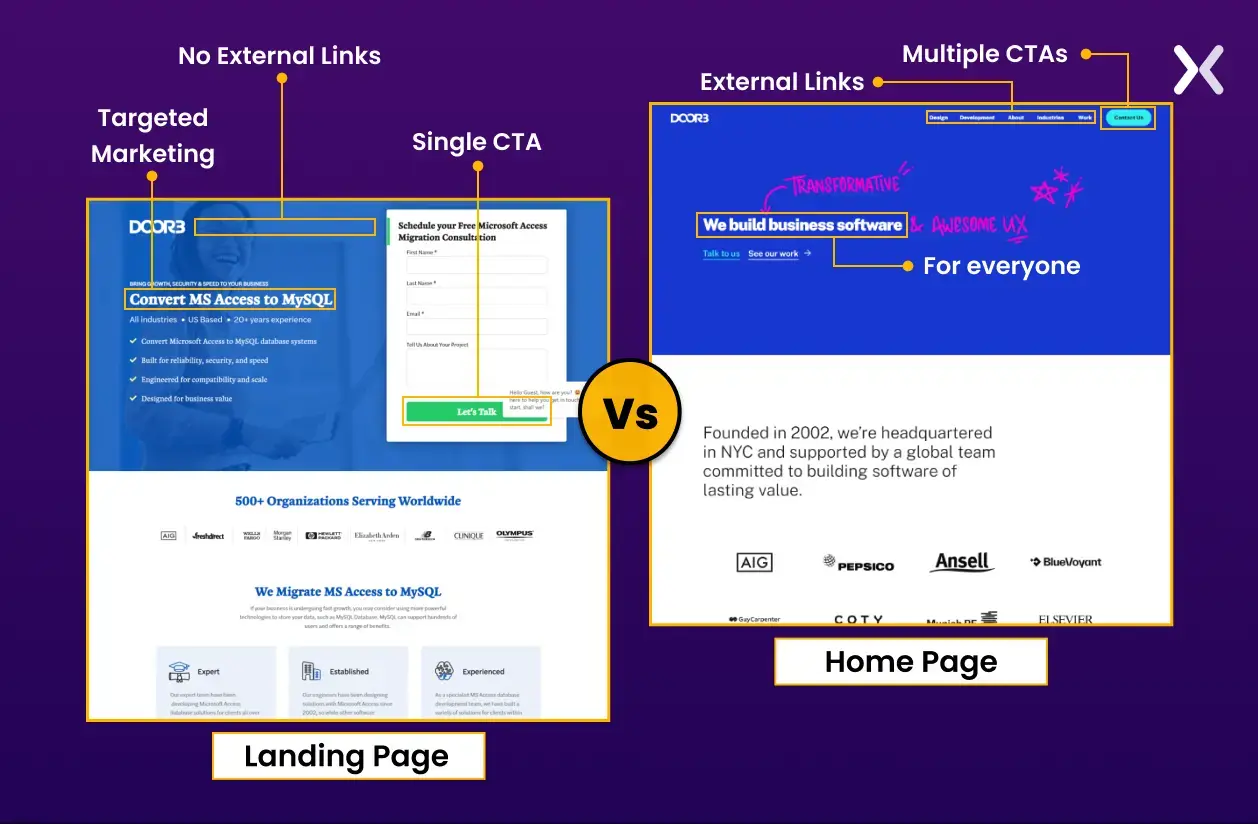
If a few points are still puzzling you, no sweat. We’ve broken them down into different sections for a straightforward ride. Let’s dive in!
It is fundamental to understand the definitions of a landing page vs homepage. This will serve as our jumping-off point.
A landing page is a standalone web page designed for a specific marketing or advertising campaign. It’s crafted to prompt a targeted action, often featuring a single call-to-action (CTA), such as filling out a form, making a purchase, booking a demo, or signing up for a newsletter.
Landing pages are purpose-built to enhance conversion rates and serve as a focused entry point for visitors from various sources like online ads, emails, or social media.
A homepage is a website’s main or introductory page, the starting point for navigation. It typically provides an overview of the site’s content and directs users to various sections or pages. Search results and SEO efforts often drive homepage traffic.
A successful marketing campaign hinges on well-defined goals. The distinct objectives of landing pages and homepages are pivotal, profoundly influencing their content, context, and design. The clarity of these goals serves as the compass guiding the trajectory of a campaign’s success.
Conversions. Plain and simple.
Landing pages aren’t about boosting brand awareness or showcasing accomplishments. Their sole purpose is conversion—turning visitors into leads, leads into clients, and clients into advocates.
Whether it’s a pre-launch sign-up or newsletter subscription, a dedicated landing page outperforms a homepage in driving both micro and major conversions. It’s a non-negotiable asset for any conversion-centric marketing campaign.
Check out RocketMoney’s landing page built by Apexure. Did you notice how simple and clean we have kept the form and design?
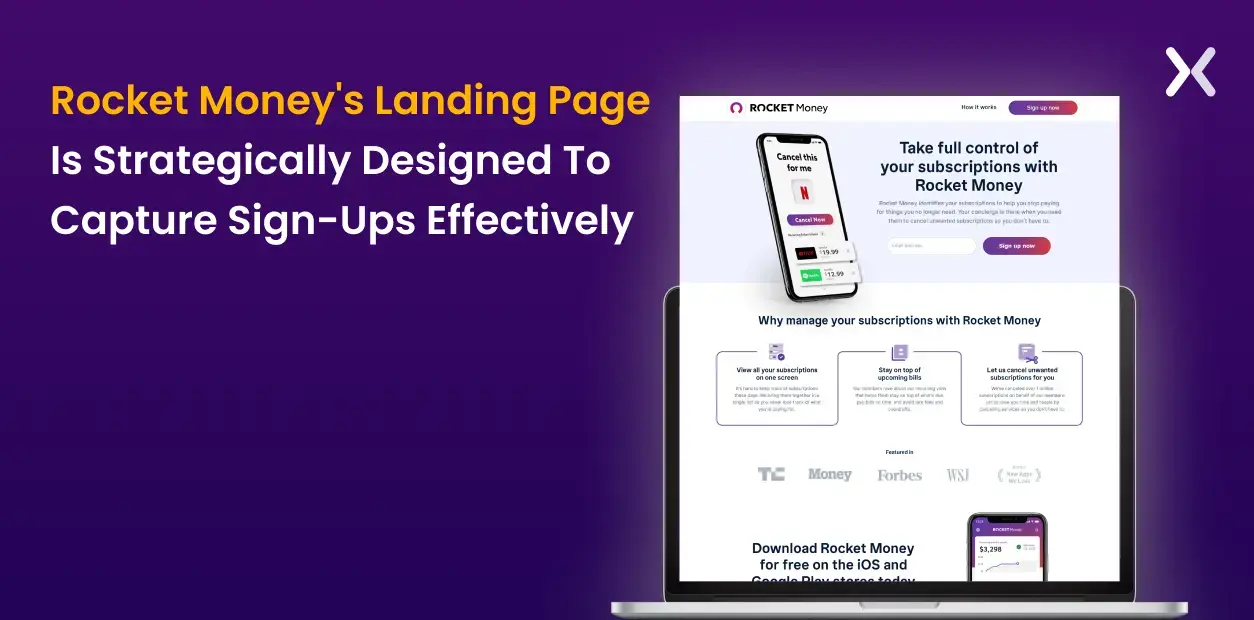
Inspire exploration.
Think of the homepage as your digital storefront in the market. Just like in a physical shop, visitors judge your brand based on appearance and content. It’s the starting point where the story unfolds—introducing visitors to your brand, services, and mission. The homepage is the gateway to your brand’s content, fostering a connection with your clientele.
Here, check out the homepage of RocketMoney, which is all about encouraging visitors to explore the website and learn everything about the brand and its products.
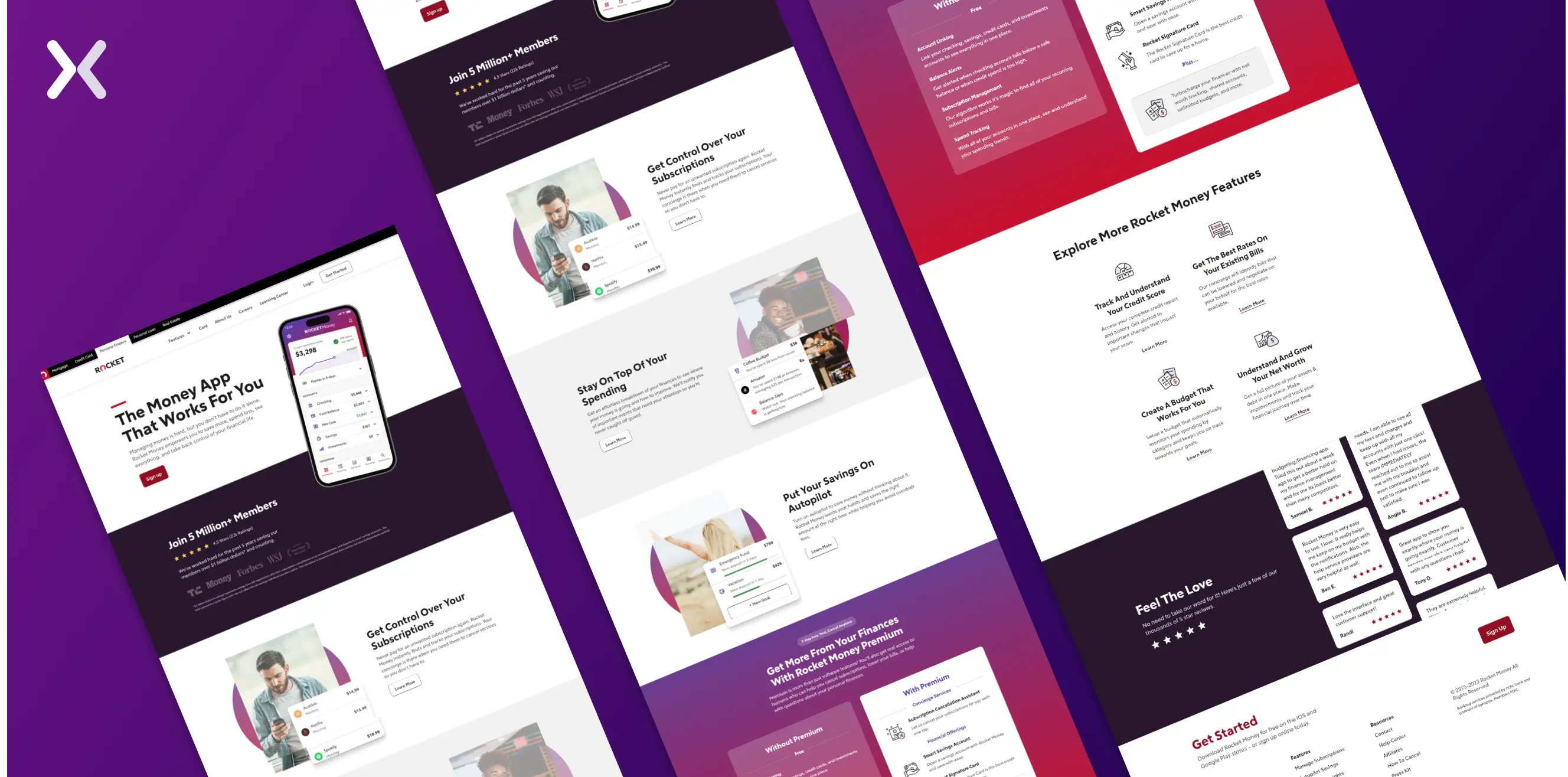
Designing homepages and Landing pages involves aligning them with the needs of your target audience. Let’s explore the specific types of audiences these two web pages target.
A specific audience segment.
Every brand caters to a diverse target audience, each with unique characteristics—varying from geographical locations to job profiles. Each segment possesses unique pain points and triggers for converting.
Attempting to address all on a single page falls short. Landing pages, being standalone, provide the flexibility to create dedicated pages for diverse audience segments.
It enhances personalization, significantly increasing the chance of conversions by respecting diverse opinions and tailoring experiences accordingly. In short, targeting the right intent.
Oji Life Labs is a standout in corporate training. In a recent campaign addressing employee burnout.
So, we built a landing page for them that highlighted the crucial role of strong managerial soft skills in overcoming the challenge and demonstrating how Oji Life Lab can assist companies in training their managers accordingly.
This strategy revolves around honing in on a specific problem that strongly resonates with their audience.
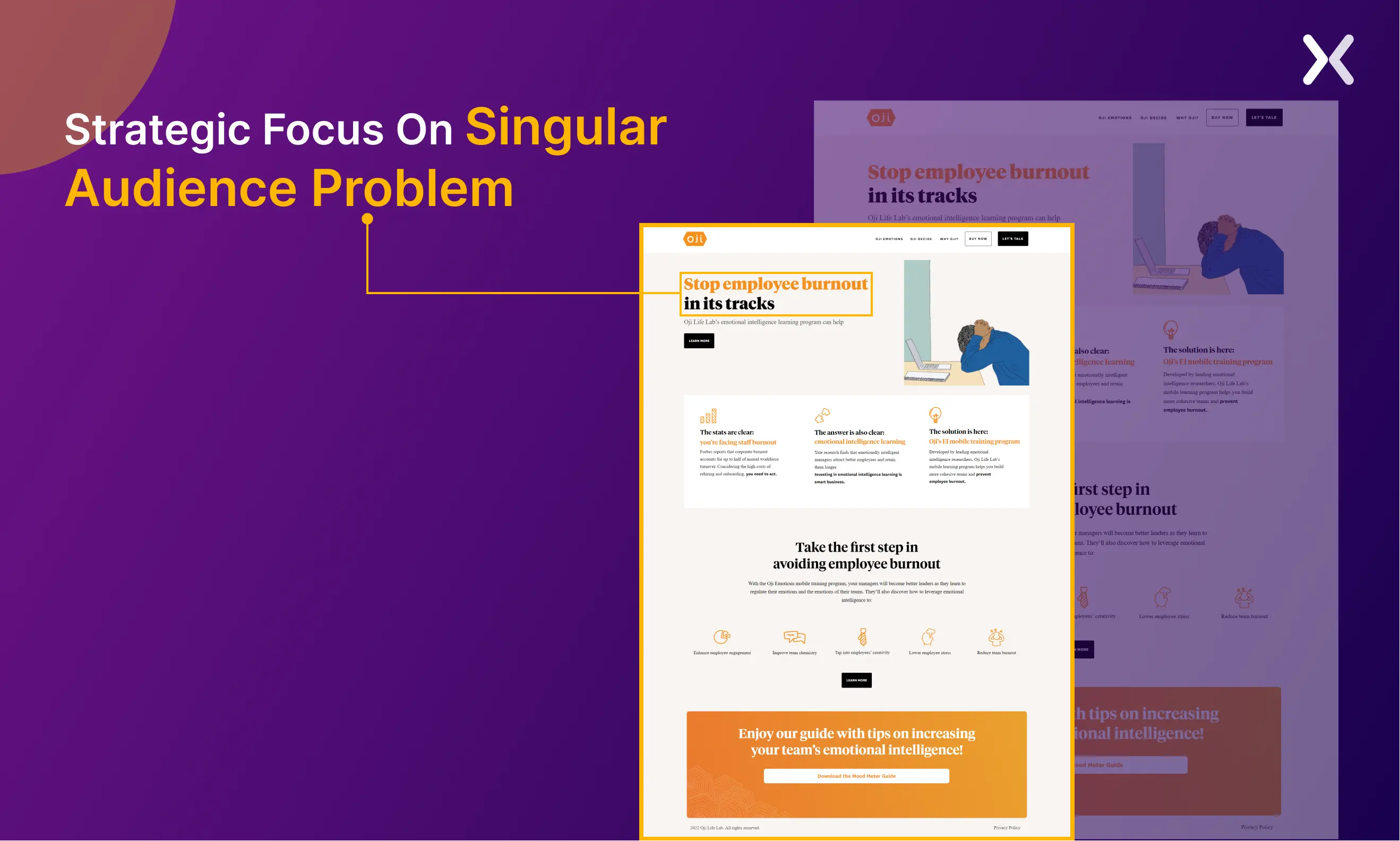
Anyone.
The target audience of a homepage is broad, encompassing all visitors who land on the main page of a website.
Unlike the specialized focus of landing pages tailored to specific campaigns, homepages cater to a diverse range of users seeking an introduction to the overall content and offerings of the website. The target audience for a homepage is anyone who initiates their journey on the site and seeks a comprehensive overview.
In contrast to their landing page, Oji Life Lab’s homepage offers a comprehensive introduction to the company’s varied services, with a specific emphasis on individuals in leadership roles and companies of diverse sizes, ranging from 10 to 50 employees.
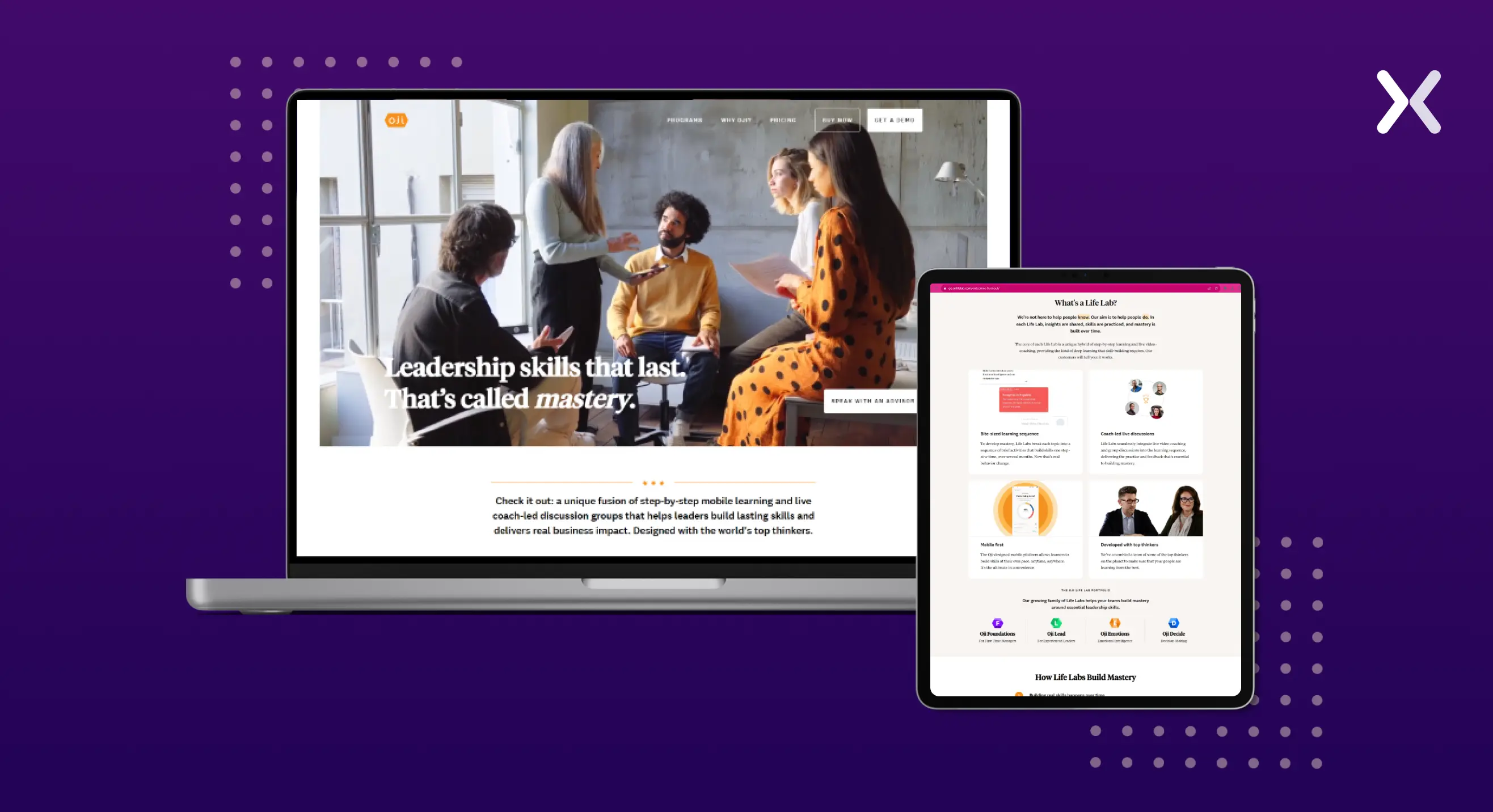
The audiences for your landing page and homepage reside in distinct phases of the conversion funnel, drawing traffic from both organic and paid sources. While organic traffic may be cost-effective, paid ads need to deliver results. The landing page addresses this challenge effectively.
Landing pages, designed for optimal conversions, are strategically employed with paid ads to elevate conversion rates—commonly known as PPC landing pages. However, the versatility extends beyond PPC, as businesses can also optimize them for search engines, attracting organic traffic effectively.
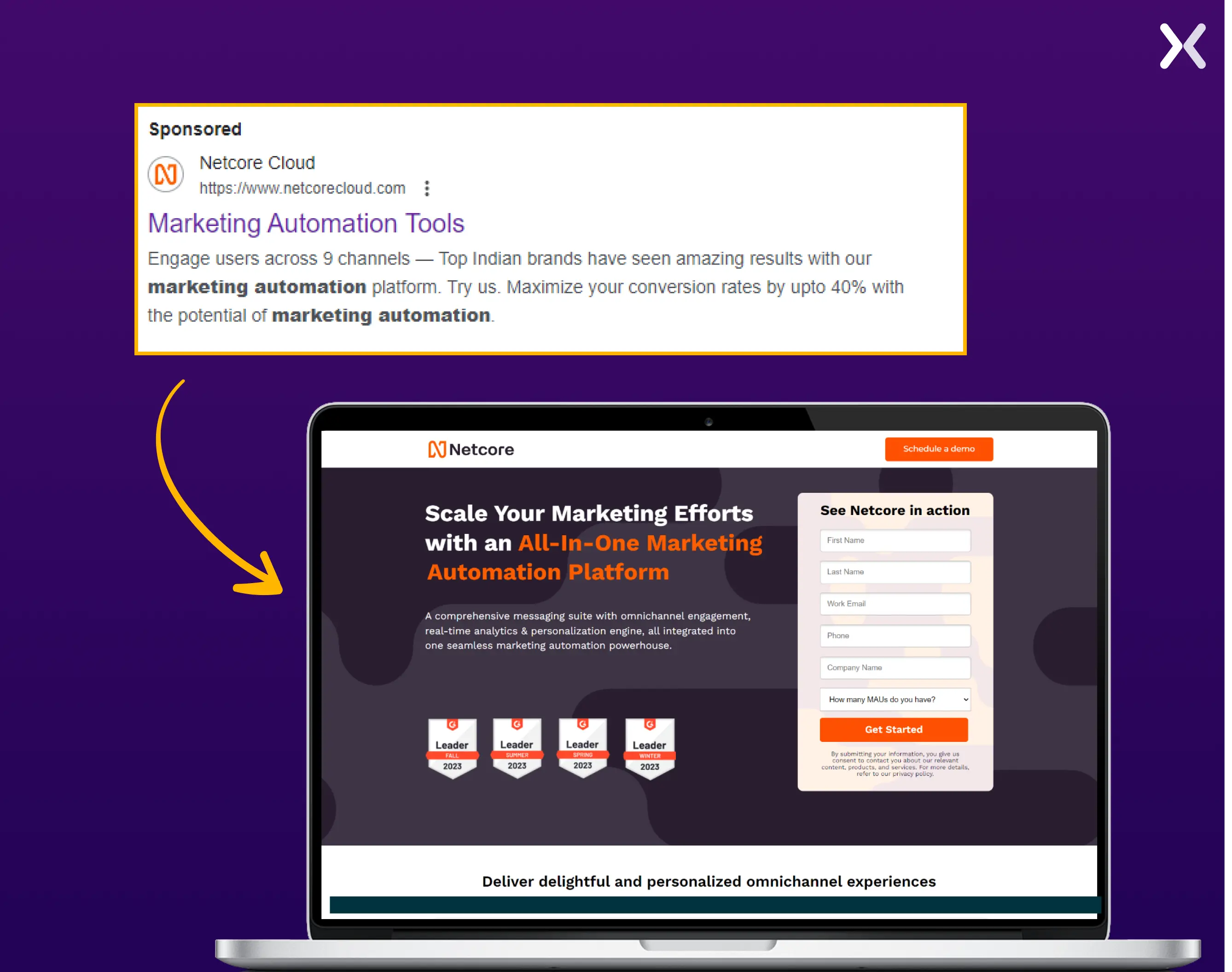
Homepages attract traffic through various channels, including direct visits where users type in the URL, search engines where they discover the site through relevant queries, referrals from other websites or social media platforms, and engagement via online advertising.
This diverse mix of sources underscores the importance of a comprehensive online presence and effective digital marketing strategies.

Clear navigation is crucial for a positive user experience, accessibility, content discovery, conversion optimization, SEO performance, and brand credibility. It acts as a virtual roadmap, guiding users through the digital space efficiently.
But then, why should a landing page not have navigation?
It is deliberately streamlined and focused. A landing page navigation menu should differ from the rest of the site.
Unlike a website’s homepage, which typically has extensive navigation menus, a landing page aims to guide visitors toward a specific action. The navigation is often minimal, emphasizing a singular call-to-action (CTA) to enhance clarity and reduce distractions.
Navbars typically brim with links to various pages, but on landing pages, the goal is to retain visitors for conversion. Hence, external navigation is removed. The only navigation that should occur is to a thank you page, and even that happens only after a successful conversion.
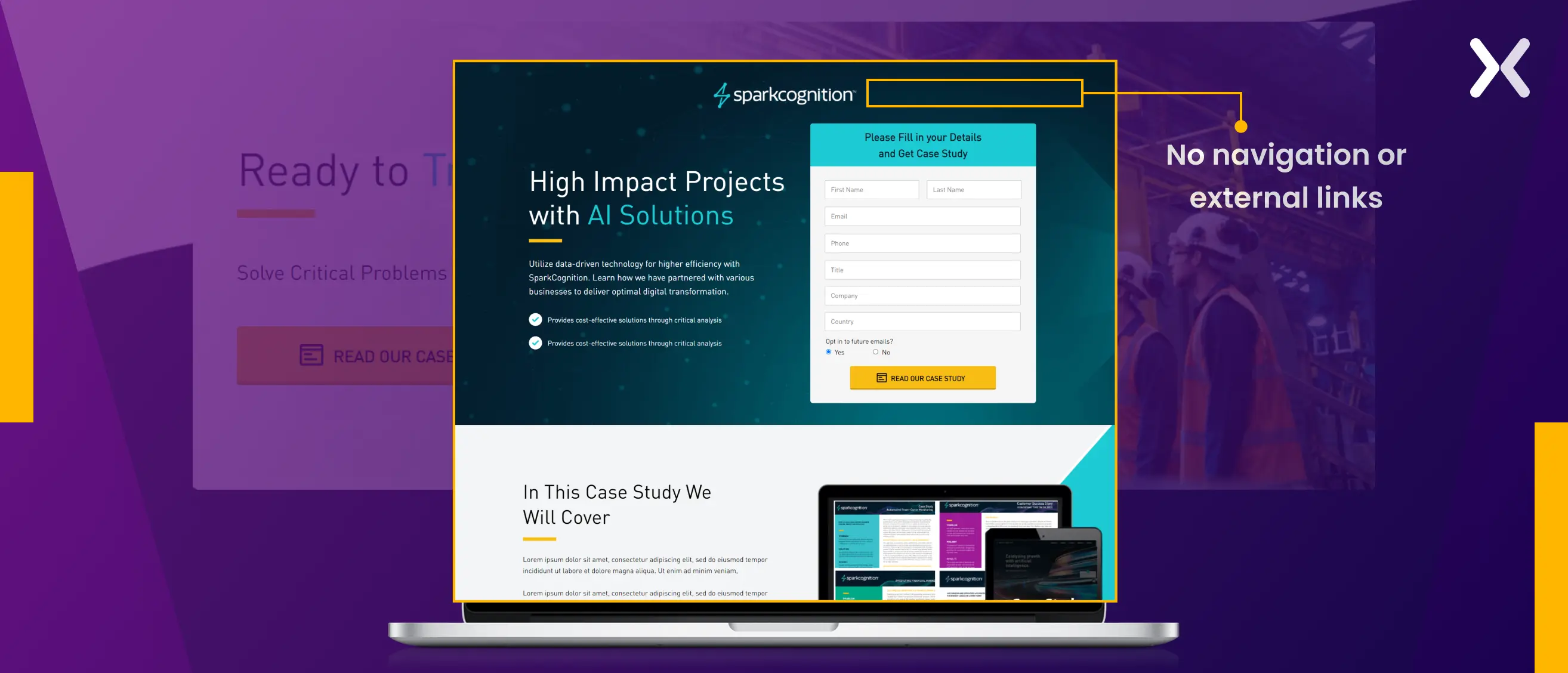
It holds particularly true for short-form landing pages.
However, for longer ones with multiple sections, an internal navbar is introduced for easy exploration within the page. It ensures a user-friendly experience on extended landing pages.
Homepage navigation, featuring a menu bar, direct links, call-to-action buttons, a search bar, and visual elements, is complemented by a dedicated footer and header. These sections share links that aid users in getting acquainted with the brand, fostering a comprehensive experience.
In Apexure’s homepage designs, navigation is key. We view the homepage as an information desk where visitors enter, seeking specific brand-related queries, and seamlessly proceed to the relevant page. For this to work well, the homepage navigation has to be clear and easy to understand.
Search engine optimization (SEO) is a crucial term for organic traffic. Let’s try to understand what value it holds for landing pages and homepages.
It is advisable not to mix them up.
SEO allows you to rank at the top of the SERPs, which ultimately invites a broad audience to your web page. You certainly don’t want that for your landing page.
A landing page is like a testing ground where you can change an element, monitor it for some time, and decide whether that element adds value to your TARGET AUDIENCE’s user experience or not. Moreover, you can replicate such elements on your main website.
An indexed landing page restricts your flexibility by surrendering control over your traffic sources. While it provides a wealth of data, this information may not necessarily be valuable due to the constrained control over traffic origins.
These are best friends.
You need to SEO your homepage as it enhances visibility, attracts organic traffic, and establishes credibility. Contrary to landing pages, which may focus more on specific campaigns or offers, a homepage serves as the virtual front door to your entire website. Therefore, it’s crucial to implement SEO strategies on your homepage for various reasons.
SEO is the key to ensuring your homepage is easily discoverable by everyone.
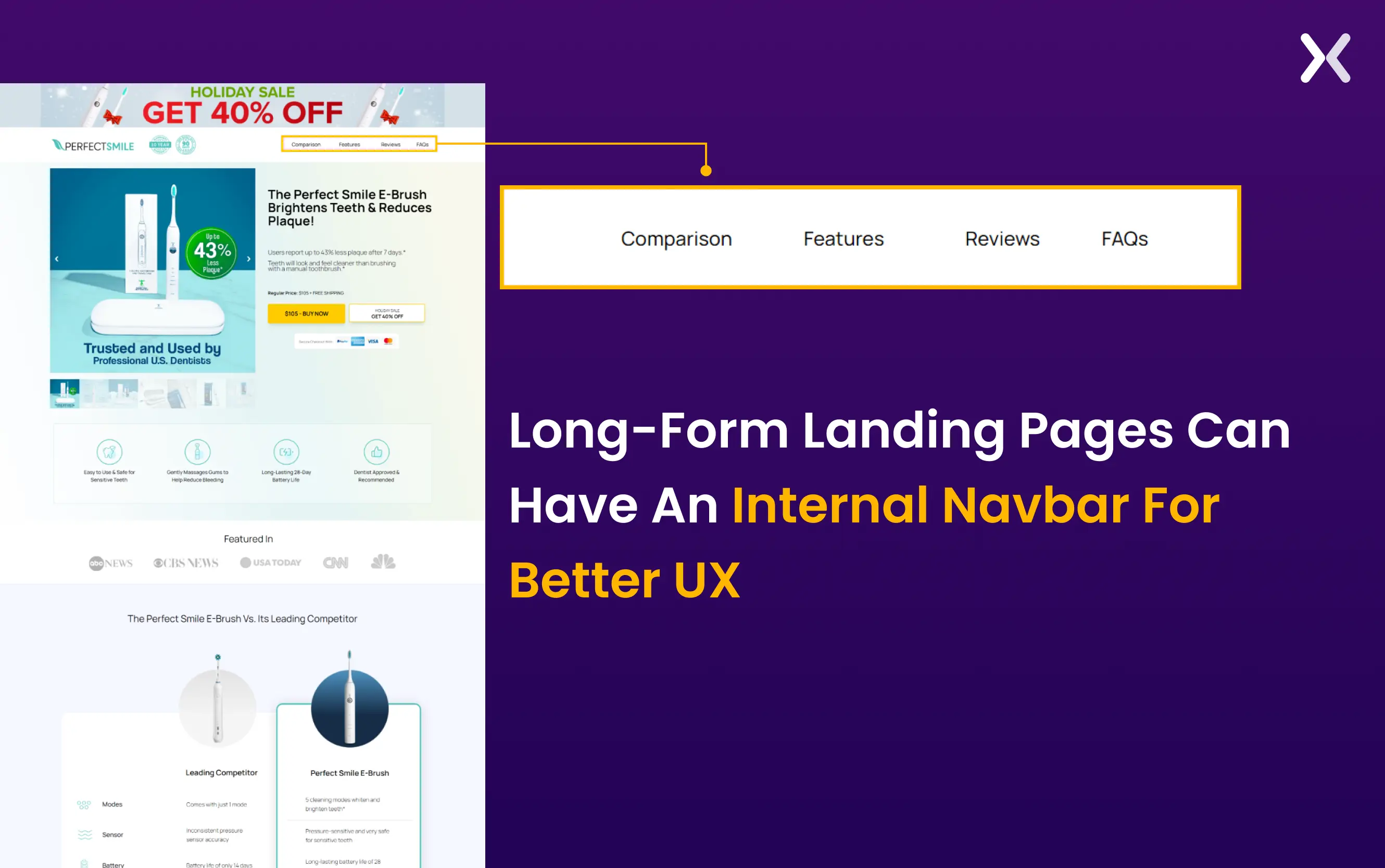
Like any marketing campaign, homepages and landing pages have KPIs and metrics that demand close attention. Tracking and analyzing these key performance indicators are essential for evaluating the effectiveness of the pages and optimizing them for desired outcomes.
Can you guess the most crucial metric for a landing page?
Undoubtedly, it’s the conversion rate.
No matter which industry the landing page belongs to be it SaaS, finance, or any other, the ultimate measure of a it’s success lies in the number of conversions it generates for the business. Additionally, the engagement rate of a landing page serves as a valuable indicator of its UI/UX status, providing insights into whether design adjustments are necessary.
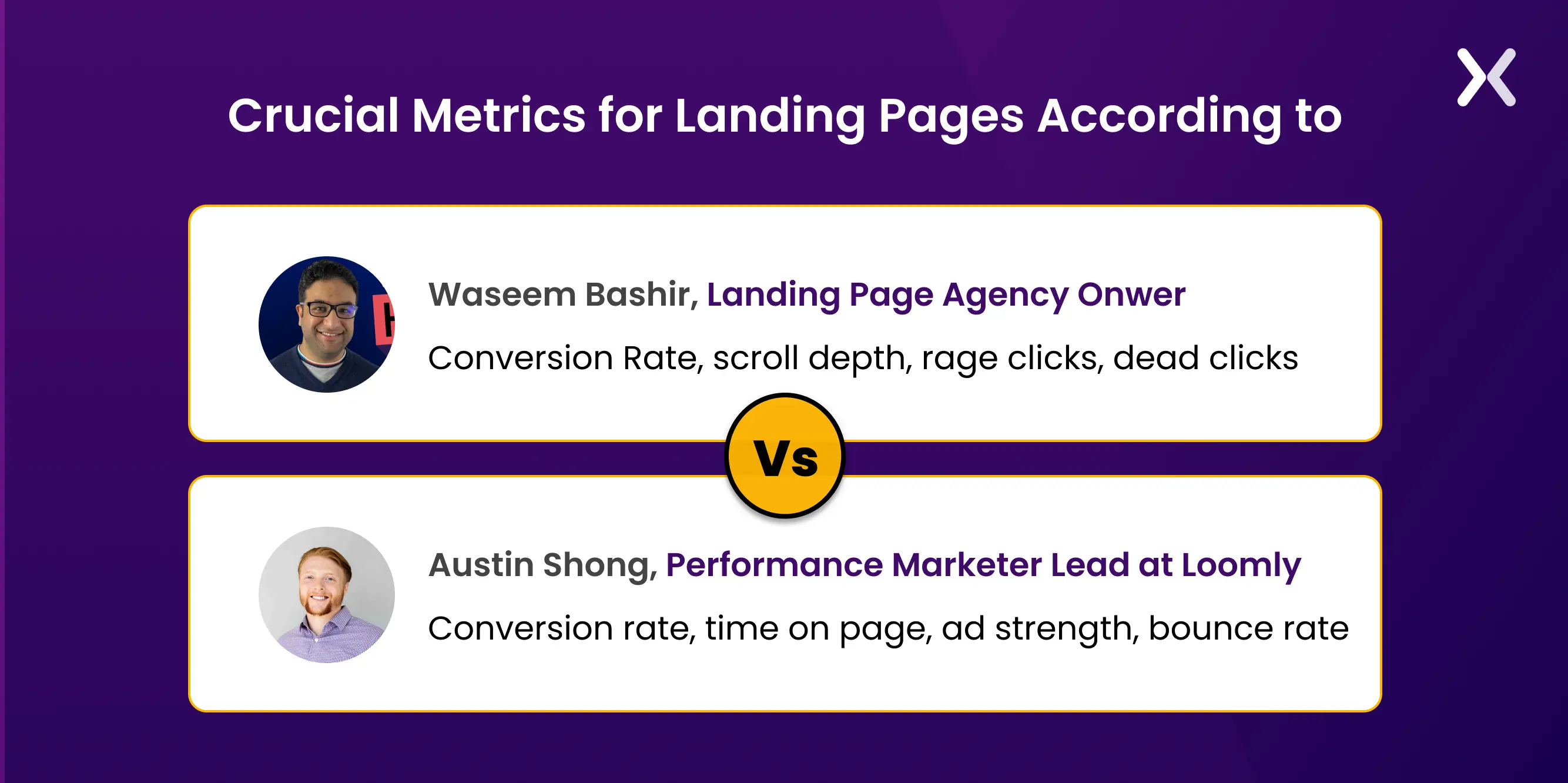
In the comparison above, we observe how landing page metrics vary based on specific needs. Austin at Loomly prioritizes optimizing ROI in PPC campaigns, centering on the analysis of landing page metrics crucial from a PPC perspective, like bounce rate and ad strength.
In contrast, a landing page agency places emphasis on identifying specific issues through tools like heatmaps, examining scroll depth, rage clicks, and other factors to enhance the overall effectiveness of a landing page.
When assessing a homepage’s effectiveness, two critical metrics are Bounce Rate and Average Session Duration.
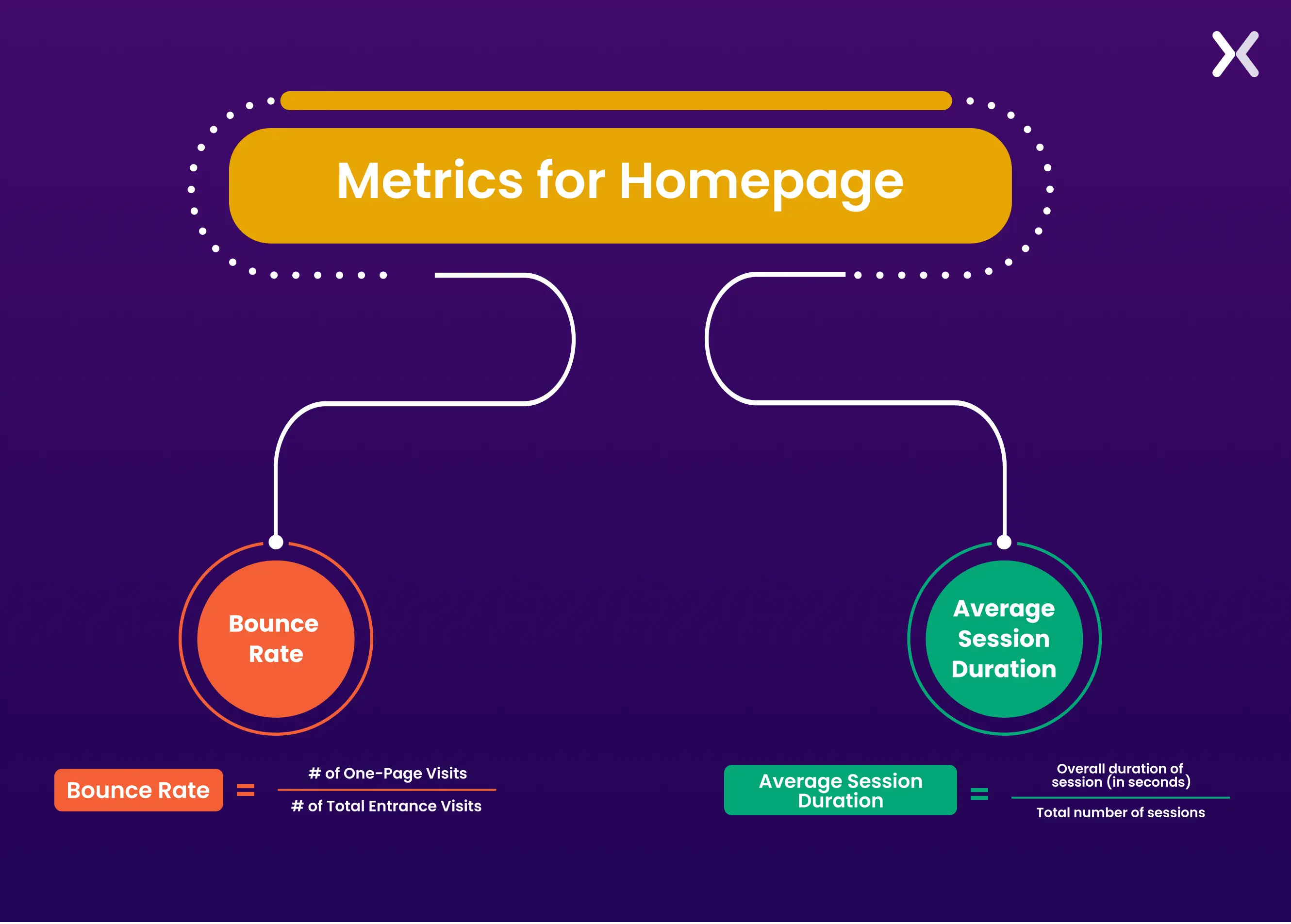
The bounce rate, representing the percentage of visitors departing without further interaction, serves as a litmus test for content and relevance. Simultaneously, the average session duration gauges user engagement, with a longer duration signaling active exploration.
These metrics provide vital insights for refining the homepage, ensuring it captivates users and aligns with desired goals.
When you combine the stats of different web pages, like the homepage and a landing page, things can get confusing. While the conversion rate is vital for landing pages, it might not mean the same for homepages. Mixing them up could lead to losing important user data.
Both homepages and landing pages are vital components of your online strategy. Homepages offer a holistic brand experience, allowing visitors to explore your brand comprehensively.
On the other hand, landing pages step in for targeted conversions in specific campaigns. The synergy of both is essential for a well-rounded strategy.
Leveraging landing pages is crucial for focused campaigns, guiding users toward specific actions like subscribing to a blog or participating in a sale. Integrated with Pay-Per-Click (PPC) ads, these pages optimize conversion potential.
Steering PPC traffic to a homepage risks distractions and low conversion rates, leading to wasted resources. Choosing between a landing page and a homepage is pivotal, influencing campaign success and cost effectiveness.
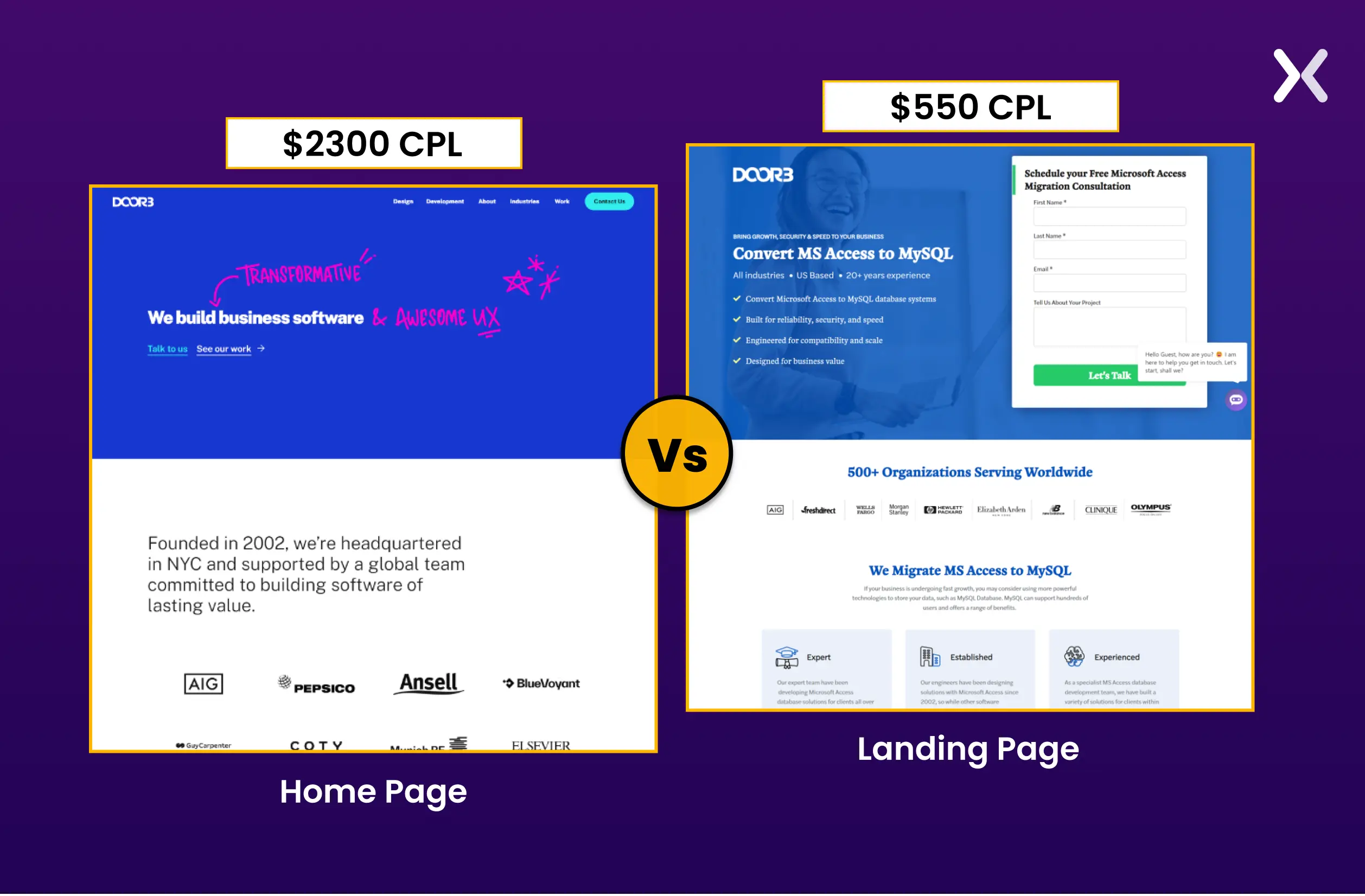
Let’s delve into a compelling case study that underscores the impact of strategic landing page use on your marketing budget. Take the example of DOOR3, a tech consulting company that initially directed all their paid traffic to their website, resulting in a staggering cost per lead of $2300.
Upon joining forces with Apexure, a transformative shift occurred. By strategically introducing well-crafted landing pages and offering comprehensive support for landing page optimization, the cost per lead plummeted to $550—a remarkable 23.9% decrease. The results speak volumes about the potency of leveraging dedicated landing pages to enhance marketing efficiency.
Distinguishing the intentions behind a landing page and a homepage is crucial. The homepage serves as the face of your brand, tailored to provide information for new visitors—typically encompassing your general background, recent news, or notable achievements.
No, a landing page is not the same as a homepage. Here is a table to help you understand:
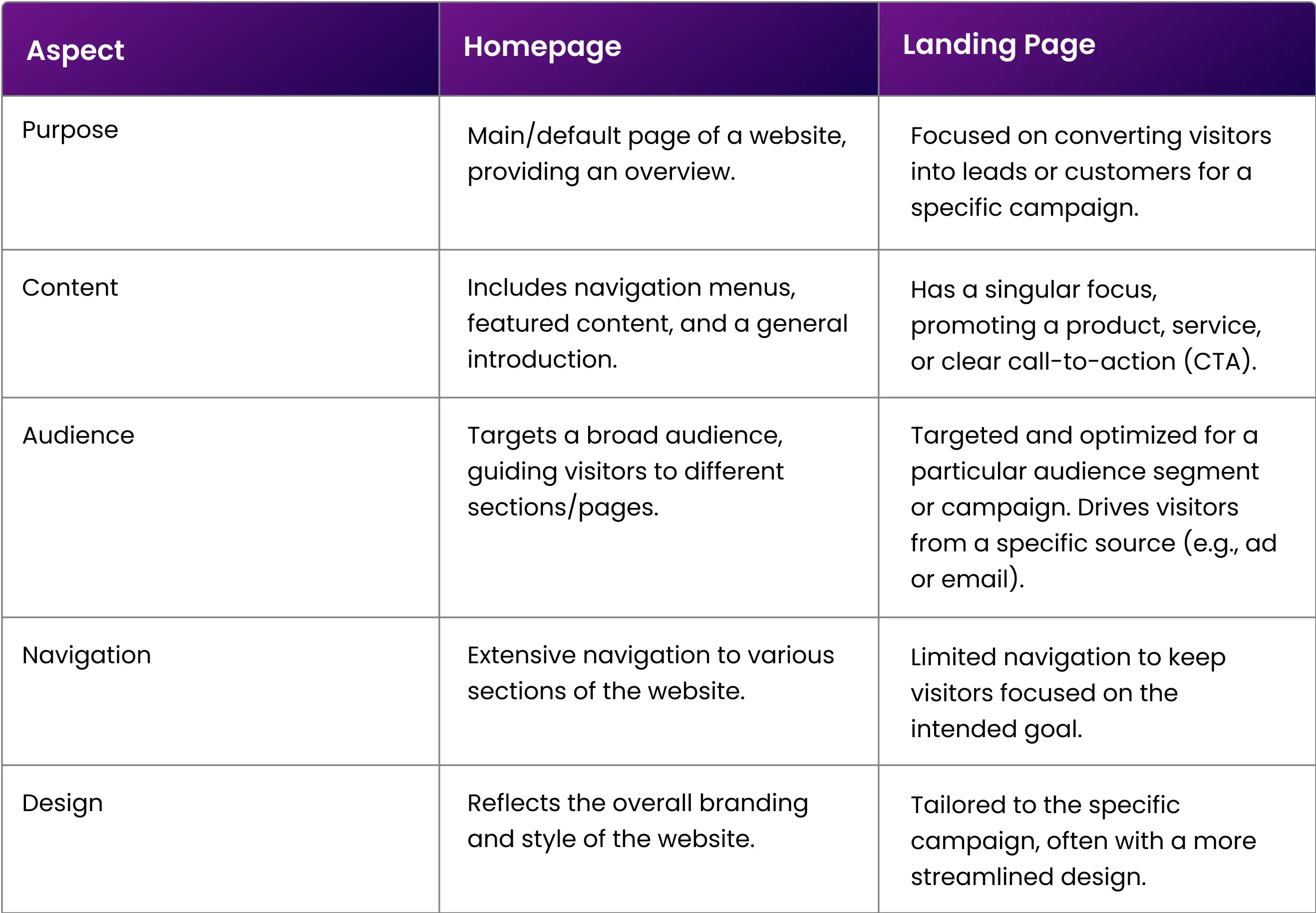
While it’s technically possible for a landing page to serve as a homepage, they are typically designed for different purposes and have distinct characteristics. Let’s explore both scenarios:
Possible but Uncommon: In some cases, especially for small businesses or single-product websites, a landing page may function as the homepage.
Focused Content: The content on this landing page would need to serve the dual purpose of introducing visitors to the overall brand and providing a specific call-to-action (CTA).
Challenges: Designing a landing page that accommodates both general brand information and a specific campaign goal can be challenging. It may result in a cluttered or less effective page.
If you’re in the early stages of launching your startup and find yourself short on time or lacking a precise understanding of your target audience, we recommend considering either a landing page as your homepage or vice versa. Such a streamlined approach can be particularly beneficial in the initial phases of your venture.
In the early stages of a startup, leverage landing pages as makeshift homepages. This allows you to establish an online presence quickly, especially when time is scarce, and a comprehensive website is still in the works. This approach is particularly beneficial when you’re refining your understanding of the target audience.
CoolRun does something similar. They’ve crafted an extensive landing page that offers comprehensive details about the company and its services. A top-mounted navigation bar enhances navigation across the entire page, culminating in a single, strategically placed call-to-action (CTA).
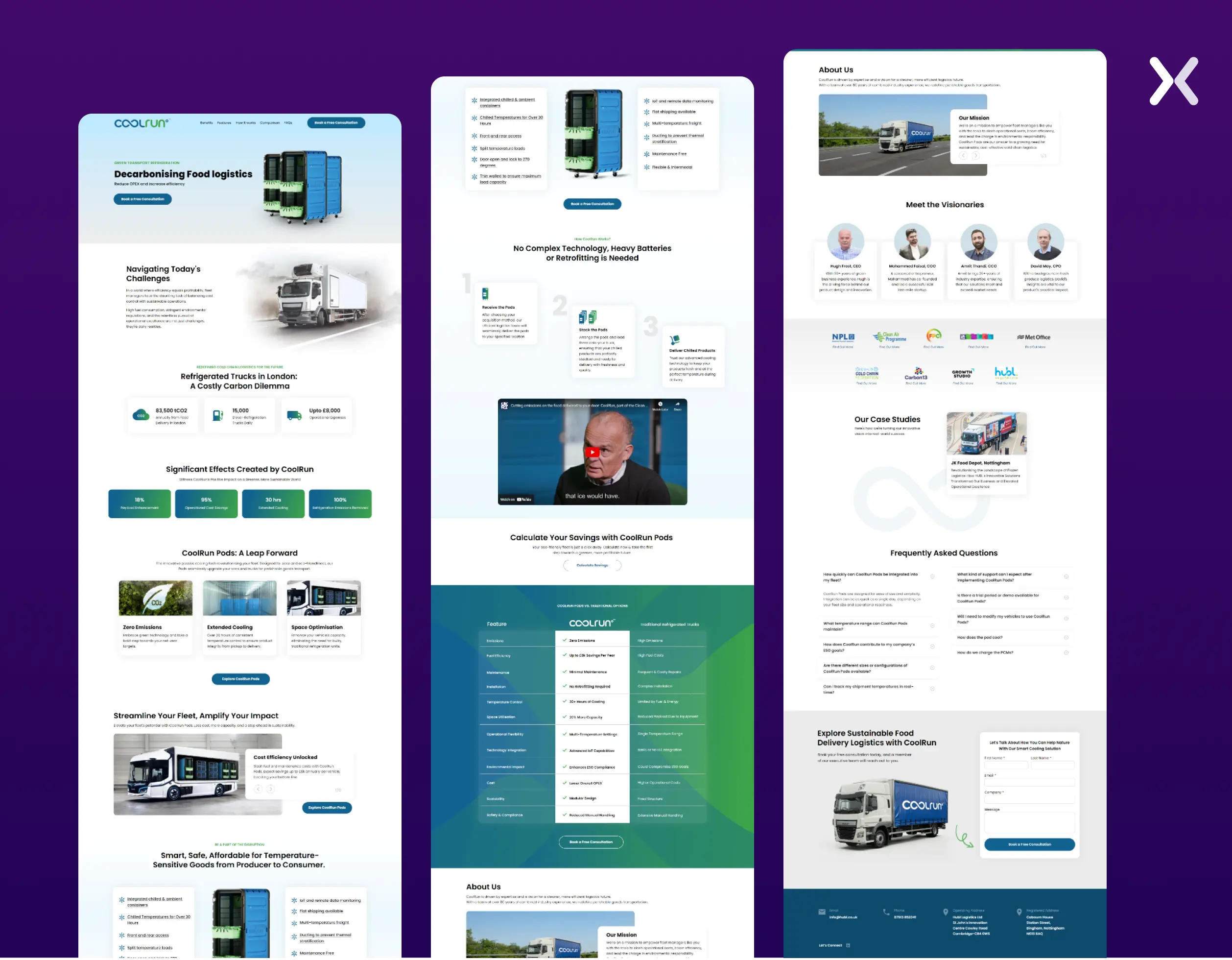
Common Practice: More commonly, a landing page is a standalone page created for a specific marketing campaign or promotion.
Singular Focus: The landing page has a singular focus, aiming to convert visitors for a particular purpose, such as making a purchase or signing up for a service.
Limited Navigation: Landing pages often have limited navigation to keep visitors focused on the campaign goal.

The distinction between landing pages and homepages is pivotal for every marketer. Landing pages are precision tools for targeted conversions, synced with PPC ads for optimal results. Homepages, on the other hand, serve as the welcoming face of your brand, offering a comprehensive exploration of your offerings.
Redirecting PPC ads to a homepage won’t optimize conversion magic. The verdict is clear: landing pages and homepages are distinct entities designed for specific purposes—craft landing pages for focused conversions and homepages for broad brand exploration.
We don’t shy away from sharing our expertise and experience. Learn from over 100+ blog posts on landing pages, CRO, and much more to make better marketing decisions.
If you are still confused about landing page vs homepage vs websites vs others, we can take care of that. All you have to do is book a call, and our expert will take care of the rest.
We post fresh marketing tips on our social handles daily and fill your feeds with knowledge that matters. Follow us to learn the latest landing page and marketing trends.
Rarely. While possible, landing pages and homepages serve different purposes, requiring careful content balance.
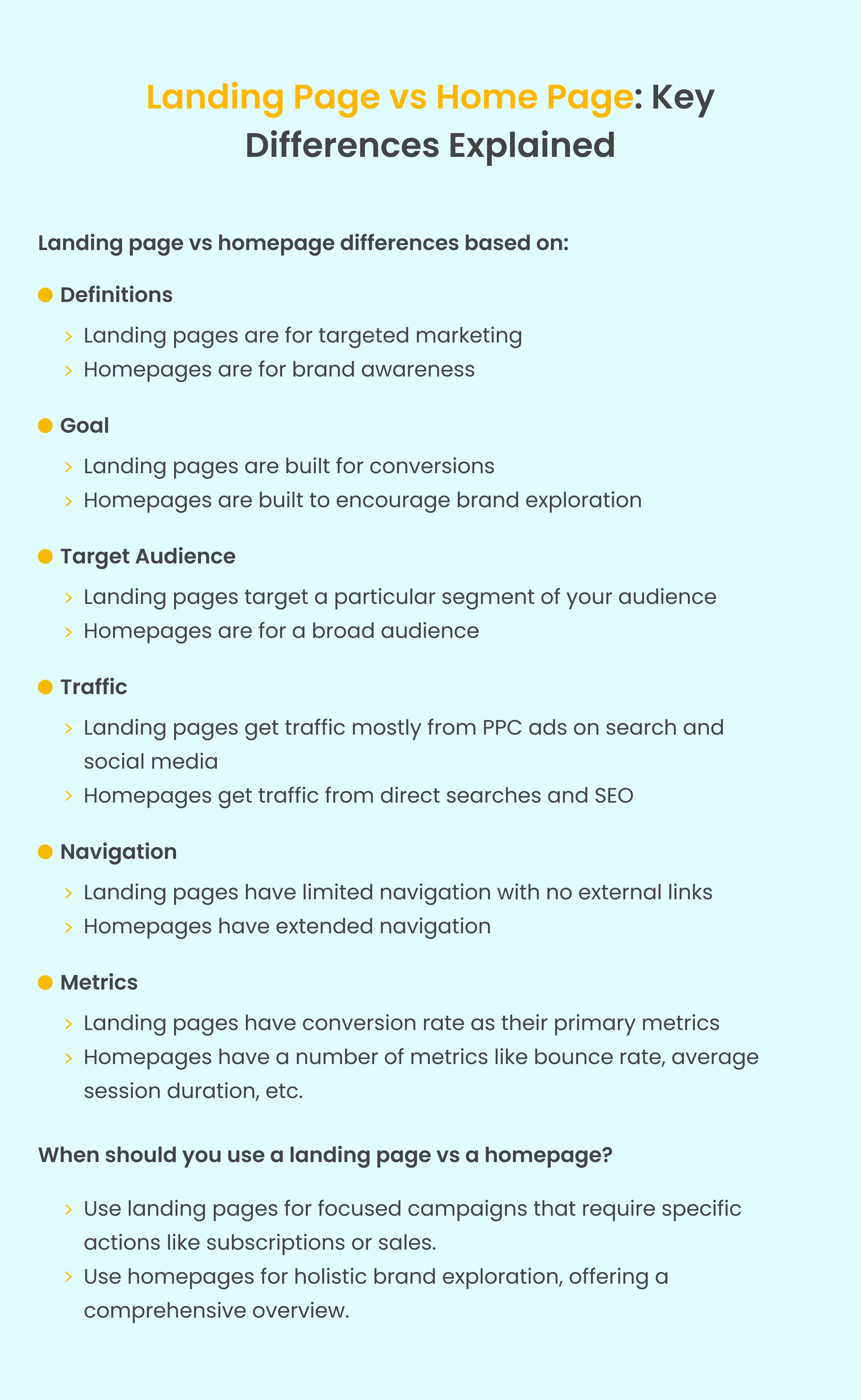
Check out our “Landing Page vs” Series:
Drive More Sales or Leads With Conversion Focused Websites and Landing Pages
Get Started.png)
In today’s fast-paced digital world, having a responsive website is no longer just a nice-to-have, it’s essential. Whether...
As artificial intelligence continues to evolve, businesses are finding innovative ways to enhance their marketing efforts. One of...
Get quality posts covering insights into Conversion Rate Optimisation, Landing Pages and great design